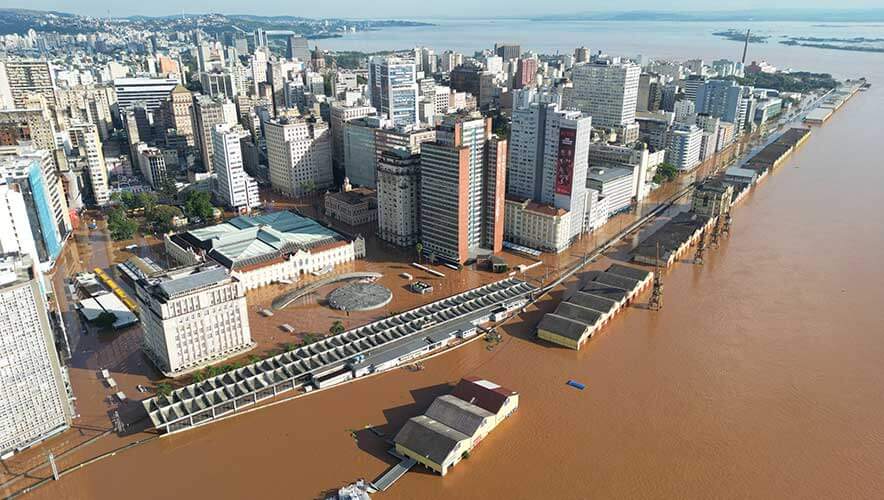Deadly Flooding Strikes Worldwide, Undercutting Infrastructure and Underscoring Resilience Needs
Flooding might be one of the most common weather-related hazards in the world, but it is also one of the most complex, damaging infrastructure, hampering hygiene, and snarling transportation, delaying aid and slowing recovery. As a result of climate change, storms are becoming more frequent and sea levels are rising, meaning that flooding will be an ongoing and worsening challenge for many regions.
Southern Brazil
A week of heavy rains have been pounding the southern Brazilian state of Rio Grande do Sul, causing record-breaking floods. So far, 75 people have been killed and more than 100 are missing in the flooding, according to the state’s civil defense agency on 5 May.
Floods and mudslides continue to threaten people in the region, and rescue workers are racing to search for missing or stranded people, according to The Guardian. Some houses were completely submerged.
On 2 May, a hydroelectric plant dam partially collapsed, and multiple cities in the Taquari River valley were overtaken by water, the Associated Press (AP) reported. Bridges and homes have been swept away, and electricity, communications, and water services have been cut across the state. The storms affected almost two-thirds of the 497 cities in the state. More than 80,000 people have had to evacuate their homes, and more than a million people lack access to drinking water.
This is the worst flooding recorded in the region since 1941.
Kenya
The death toll from flooding and other effects from the heavy rains in Kenya rose to 228 on 5 May, and the torrential rains are expected to get even worse later in May and into June, Reuters reported. At least 164 people have been injured and more than 212,000 have been displaced. Kenyan interior cabinet secretary, Kithure Kindiki, announced on 2 May that 178 dams and reservoirs could “spill over any time,” ordering people living near them to evacuate or be forcibly removed.
Broad swaths of Kenya have been hit by flash floods, including Nairobi and parts of the Maasai Mara wildlife reserve. While Kenyans expect heavy rain during its annual rainy season (March through May), the scale of this month’s rain has been shocking—in two days, more than half a month’s rain fell on parts of Kenya, according to CNN.
The death toll in the Kenya flooding rose to more than 180 people since March, the government and Red Cross said, and hundreds of thousands have been forced from their homes https://t.co/6Muv1qYkzp pic.twitter.com/qlWMlXEZ96
— Reuters (@Reuters) May 2, 2024
Local residents blame the extent of the damage on a lack of investment by the government, including poorly maintained, frequently blocked drain systems, Al Jazeera reported. Low-income neighborhoods and informal settlements were his especially hard because they have fewer solid structures, congestion, and poor sanitation infrastructure.
Climate change makes the threat of sudden flooding in Africa more likely because a warmer atmosphere can hold more moisture. According to the sixth Intergovernmental Panel on Climate Change (IPCC), “With additional increases in global warming, changes in hot and cold temperature extremes, mean and maximum one-day precipitation get larger.” At 2 degrees Celsius (C) of global warming, total annual precipitation across portions of central Africa will easily hit a 40 percent increase over current rates.
United States
Around 11 million people in the U.S. states of Texas and Oklahoma were under flood watches and warnings this past weekend, and storms on 3 May forced multiple high-water rescues, CBS News reported.
During a five-day period last week, more than 21 inches of rain fell in one county in Texas, where 178 people had to be rescued. One 4-year-old boy was killed after the vehicle he was in was stuck in swift-moving water during the storms.
Flood Resilience
Heavy one-day storms are likely to get significantly more rainy as global temperatures rise, the IPCC found. If temperatures climb to 1.5 degrees C over preindustrial levels, one-day storms will get 10.5 percent wetter. If temperatures reach the 2 degree threshold, rainfall will likely increase by 14 percent, and at 4 degrees C, rainfall will increased by 30.2 percent during heavy one-day storms.
Communities are not designed to withstand repeated heavy flooding, according to an article from the World Economic Forum. Pavement contributes to urban flooding because water runs off it quickly and is not absorbed. After forest fires or extended droughts, water runs off soil rather than soaking in, resulting in overwhelmed drainage systems and flash floods.
“Failures in maintaining infrastructure, such as levees and storm drains, are a common contributor to flooding,” the article noted. “If the infrastructure is well designed and maintained, flood damage can be greatly reduced. However, increasingly, researchers have found that the engineering specifications for drainage pipes and other infrastructure are no longer adequate for the increasing severity of storms and amounts of precipitation. This can lead to roads being washed out and communities being cut off.”
Flooding is also a complex and interconnected threat to communities and regions. Floods damage recovery resources, such as roads and hospitals. Flooding is also not just an influx of water—it can trigger mudslides, make sewers more vulnerable, and exacerbate contamination risks from manufacturing sites, and risk mitigation measures upstream can worsen flood risks downstream, as seen around Houston, Texas.
A scientific review in 2022 found that flood research is following this trend, moving from flood control measures to flood resilience, adjusting mitigation measures to study more sustainable plans to cope with flood disasters and recovery more effectively.
The researchers concluded that “integrating the concept of resilience into the framework of risk management is a better approach in future flood management directions. Consequently, appropriate options and decisions prior to disaster, during disaster, and post-disaster will effectively reduce the adverse consequences using the theory of risk, resilience, and sustainability.”
Climate change-related disasters pose ongoing challenges for business continuity and security professionals, wrote Hans Fah for Security Management in 2023.
“The built world is heavily reliant on the stability and predictability of the climate,” he wrote. “From agriculture to infrastructure planning, understanding factors such as where it will rain, how much it will rain, and when it will rain is critical to the functioning of our societies. But climate change is now increasingly disrupting such norms.”
He continued: “As a security risk professional, you may still doubt the relevance of climate change to your role, but it’s important to understand that climate threats are not limited to the natural world and can propagate consequences for security stability at multiple levels—from geopolitics and national security down to security at operational levels. With climate change, everything is connected.”
Read more about the interconnectivity of climate change, resilience, and security in this package of articles from Security Management.












